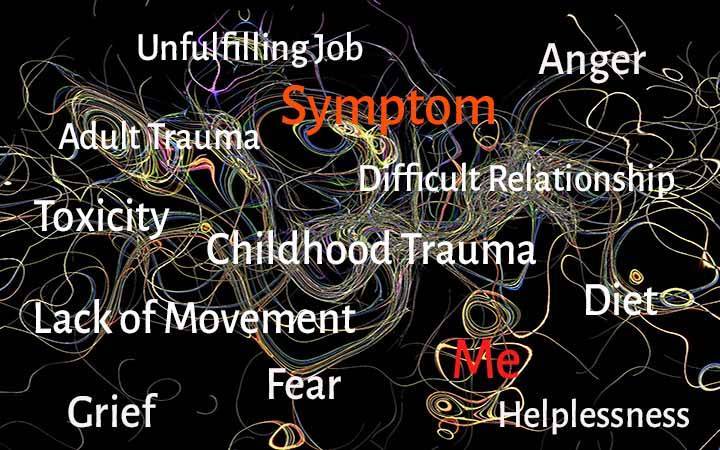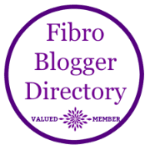The Anatomy of a Symptom
For those of us with fibromyalgia, chronic illness or simply ongoing nagging physical or emotional symptoms, we want the symptoms to go away. We want good health. We want to feel good. As well meaning as this is, our search for health can become a war against the symptoms and our own body.
Our physical or emotional symptoms are our friends, not the enemy
In my early years of studying holistic health, I was introduced to the idea that symptoms were our friend, not the enemy. At first this sounded outrageous, but as time went on, I began to understand the importance and power of this truth.
Over the years, I have learned the application of this in rebuilding health. The power of this is understanding the underlying cause of the symptoms. That is where your power lies . . . not in fighting a symptom. The symptom is the guide to the underlying cause.
The Anatomy of a Symptom
To assist in understanding this, I am going to explore the anatomy of a symptom. I have people who come to me and ask me what they need to do to get rid of a symptom. Without knowing more information about them and their symptoms, my truthful answer is, “I don’t know.” I teach people how to rebuild their health from the inside out rather than try to get rid of a symptom. I take people on a journey of discovering and resolving the underlying causes.
Let’s take pain for an example. If you have chronic pain, there can be many causes. A pain pill might alleviate they symptom but is not addressing the underlying cause. Here are some possible causes of pain:
- Poor diet
- Lack of exercise
- Suppressed emotions
- Cellular toxicity
- Trauma
- Unconscious beliefs
- Poor posture
- Imbalanced lifestyle
- Energetic imbalances
- Lack of self-love
More often than not, the underlying cause is a combination of the above. You tell me, is there a pill out there or one healing modality that is going to explore and or resolve all these underlying causes? If there is, I haven’t found it and that isn’t from the lack of trying.
There are many resources that have explored the potential causal factors underlying symptoms. Here are just a few.
In his book, Love Your Disease, It’s Keeping You Healthy, Dr John Harrison explores the impact of our upbringing on our health. It is about how family attitudes and behaviors can imprint an unconscious disease mindset into us from our early childhood.
German New Medicine is a body of medically documented case studies showing the connection between trauma and physical symptoms. Dr Ryke Geerd Hamer spent 40 plus years studying the relationship between trauma and illness and documented over 40,000 case studies confirming his discoveries. He scientifically documented the impact of a shock or trauma on a person and how and why the illness is born and how it is resolved.
The study of homo-toxicology (the impact of toxicity on the human body) by Hans-Heinrich Reckeweg, identifies 6 phases that the body goes though as toxins accumulate in the body. Each phase shows specific symptoms as health declines.
The Chinese 5 element theory describes the interrelationship between organs, emotions, and symptoms and demonstrates how symptoms in one part of the body, mind or emotions, can be caused by something seemingly unrelated.
The Adverse Childhood Experiences Study (ACE Study) is a research study conducted by the U.S. health maintenance organization Kaiser Permanente and the Centers for Disease Control and Prevention.[1] The study has demonstrated an association of adverse childhood experiences (ACEs) (aka childhood trauma) with health and social problems across the lifespan.
For thousands of years, yogi’s have been aware of the mind, emotion, body, spirit connection. The mind is a subtle body and the body is a gross mind. The thoughts in our subconscious mind are mirrored by the body. This relationship is thoroughly explored the book, Bodymind by Ken Dychtwald.
Bruce Lipton, in his book “The Biology of Belief” also looks at the relationship between subconscious thoughts, the emotions and the body.
Candice Pert, in her book Molecules of Emotions, explores the relationship between the mind, emotions and our body.
The Institute of Integrative Nutrition teaches us that our food, isn’t just what we put on our plate, but satisfaction in our relationships, careers, exercise and spirituality all play a part in our health.
A symptom is the tip of the iceberg
In light of this massive body of information, it becomes apparent that a symptom is just the tip of the iceberg. If we understand this relationship, we can use our symptoms as a starting place to discover the underlying imbalances or underlying causes of the symptom. Here are some things that a symptom might be able to lead us to:
- A symptom could be telling us that our lifestyle is out of balance. Too much work, not enough play and relaxation. Our relationships are imbalanced with lack of communication and connection. We need to move our bodies more or less. We are not eating the right foods for our unique bio-individuality.
- A symptom can be part of a healing process that our body has initiated to bring it back into balance.
- A symptom can help us to discover and release suppressed anger, sadness or fear.
- A symptom can be telling us that our toxic work environment or the chemicals in our makeup or cleaning products is making us sick.
- A symptom can help us to discover a subconscious belief that is undermining our life.
The Good News
The good news is that with awareness and compassion, we can understand the underlying causes of symptoms. With this awareness, we can resolve the underlying causes. We can make changes to our diet and lifestyle. We can recognize and unravel the traumas and suppressed emotions. We can discover our unconscious beliefs and allow them to shift. Awareness is the magic potion to initiate change. Awareness is the first step to change and health.
The Challenge
The challenge that we are faced with when we have physical or emotional symptoms is to discover and resolve the underlying causes of our dis-ease. Discovering and unraveling the underlying causes / matrix of your symptoms is a journey, not an event.
Rebuilding our health is a process of self-empowerment. What can we do to impact our health? What are the underlying causes, what is hiding in our subconscious memory that is impacting our health.
This is where a qualified wellness coach can be helpful. They understand the landscape and can assist you in discovering the underlying causes, resolving them and then bringing the system back into balance.
The longer I work to rebuild my own health and coach others in doing the same, the deeper this understanding goes. I also see how discovering and resolving the subconscious matrix of thoughts, emotions and beliefs is fundamental to our health. I see how powerful the impact of awareness is in shifting our health both in positive and negative ways.
Awareness Practice
This week:
- What symptoms seem to take the greatest toll on your energy and life?
- Take and inventory of your lifestyle and dietary choices.
- What choices do you make that improve your health?
- What choices do you make that hinder your health?
- Where do you feel stuck in finding the underlying cause of your symptom?
- Where are you unable to make changes you want to make? (a sign of a subconscious program running)
Be gentle and loving with yourself with this introspection. This isn’t about right or wrong, but its is about getting familiar with yourself and meeting yourself with compassion.
Coming Soon:
In January, I will begin offering online webinars to teach you how to discover and unravel the matrix underlying your health challenges. Stay posted for more information.


